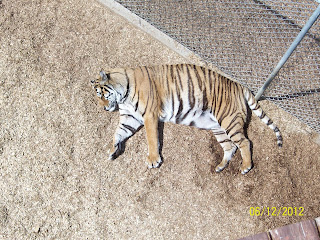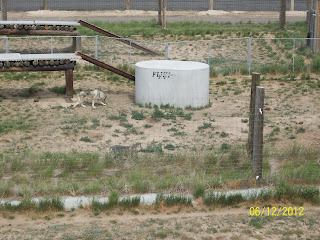We didn't have an appointment so we are just hanging around until it's our turn to see the technicians. They have a pretty good system and we get to relax in the camper until it's our turn.
This is a good time to continue blogging about our exploration of the Rocky Mountain National Park. The last blog ended with us on the Trail Ridge Road half way over the mountains at the Alpine Visitor Center.
The trip over Trail Ridge Road is an exhilarating experience. Honored as one of America's national scenic byways, Trail Ridge Road climbs to 12,183 feet above sea level, where climatic conditions, plants and animals are similar to those found near the Arctic Circle. For every 1,000 feet in elevation gained, the temperature drops 3 degrees to 5 degrees Fahrenheit, as if you had driven 600 miles north.
We traveled along this spectacular highway passing through diverse ecosystems that change as elevation is gained and lost. A journey that began in open woodlands soon passed through dense forests before entering a high, vast, treeless land - the alpine tundra.
The Alpine Visitor Center is located at Fall River Pass, the dividing point between the Fall River and Cache la Poudre River drainages. The rivers later meet east of Greeley, Colorado, joining for the journey to the Gulf of Mexico through the Platte, Missouri and Mississippi river drainages.
The great natural amphitheater below the Alpine Visitor Center has been filled with glacial ice many times in the past.
We continued over the mountain to Milner Pass where the Trail Ridge Road crosses the Continental Divide.
At this point the waters enter either the Atlantic or Pacific drainages. Here, the chance fall of a drop of water - by only a matter of feet - will determine its future course. Poudre Lake, perched atop Milner Pass, releases its cold water into the Cache la Poudre River, which flows Eastward toward the Atlantic Ocean. Milner Pass was named for T.J. Milner, an ambitious railroad promoter who surveyed a rail route from Fort Collins across the Continental Divide to points west. Like many surveyed routes of the 1880s, the railroad line was never built.
We continued on down through the forest to the Kawuneeche Valley below.
Before the Ice Age, the Kawuneeche Valley was a narrow, V-shaped, stream- cut valley. The erosive power of several massive Ice Age glaciers widened and deepened the valley to its present U shape. The ice that scoured the Kawuneeche Valley was more than 2,500 feet thick.
Here is the Colorado River flowing through the Kawuneeche Valley.
Ten miles upstream, one of the world's mightiest rivers begins - the Colorado. Its headwaters, up the Kawuneeche Valley spring from the continental Divides western slopes and Never Summer Mountains. From this modest start, the Colorado flows more than 1,400 miles to the Gulf of California.
Downstream, hundreds of tributaries enter the Colorado. This vast watershed supplies most of the Southwest with water for agriculture industry, and growing populations.
The valley is home to the Holzwarth Historic Site.
In 1917, John Holzwarth Sr. staked a homestead claim in this valley with the intent of building a cattle ranch. After the Fall River Road through the park opened in 1920, the ranch was re-developed into a popular resort know as the Holzwarth Trout Lodge.
This homestead cabin was built in 1902 by another valley settler and marks the beginning of the half-mile trail leading to the site.
Besides the rustic cabins there were many out buildings including this taxidermy shop.
We continued on through the valley to the parks western exit at Grand Lake. Grand Lake is a vacation community like Estes Park but Estes Park has a lot more activity and people by far.
We headed back through the valley and up the mountain again crossing the Continental Divide. Along the way we passed these Elk grazing along the side of the road.
They sure are magnificent animals.
On the way home to the camper we passed through Estes Park where we stopped for supper. (Did I mention we liked to eat out?)
It was a great long day but it was good to get back home and prop up our feet.
This is enough for this blog. Next blog I will continue our adventures through the Rocky Mountain National Park where we traveled a dirt road up the mountain and hiked to a summit.
What a great place the Rocky Mountain National Park is. Our country has so many wonderful places we will not live long enough to see it all, but we'll try!































































